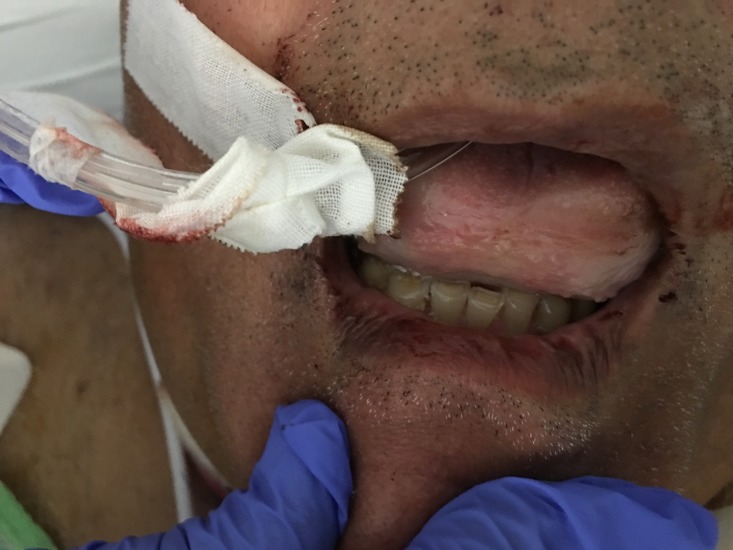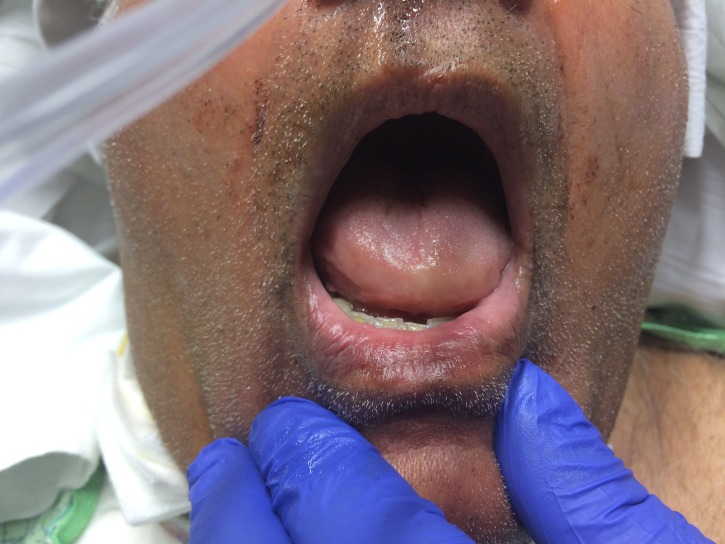Abstract
Angioedema is a severe form of an allergic reaction characterized by the localized edematous swelling of the dermis and subcutaneous tissues. Angiotensin-converting enzyme inhibitor-induced angioedema (ACEI-IA) is an allergic reaction that can be severe in some cases requiring advanced management measures. Fresh frozen plasma has been used off-labeled in some case reports to improve and to prevent worsening of the angioedema in a few cases of ACEI-IA. We are reporting this case to increase the awareness of physicians and to widen their therapeutic options when encountering this clinically significant condition.
Keywords: fresh frozen plasma, angioedema, angiotensin-converting enzyme inhibitor
Introduction
Angioedema (AE) is a severe form of an allergic reaction characterized by the localized edematous swelling of the dermis and subcutaneous tissues, usually involving the head and neck area (face, lips, tongue, larynx, pharynx). Angiotensin-converting enzyme inhibitors (ACEIs) are commonly prescribed cardiovascular medications known to cause angioedema in some patients [1].
Case presentation
A 66-year-old Asian male presented to the emergency department with the acute onset of tongue swelling after taking his usual dose of lisinopril that evening. His past medical history was significant for hypertension, hyperlipidemia, diastolic congestive heart failure, rheumatoid arthritis, and Stevens-Johnson syndrome secondary to allopurinol and penicillin use in the past. The patient had been on lisinopril for almost a year. Other home medications included carvedilol, hydrochlorothiazide, simvastatin, aspirin, methotrexate, and folic acid. The patient denied constitutional symptoms, sick contacts, and recent travel. On presentation, physical exam, including vital signs, were normal except for a loss of phonation and a markedly swollen tongue, obscuring the entire soft palate, with a Mallampati Class IV (Figure 1).
Figure 1. Markedly swollen tongue obscuring the entire soft palate.
Complete blood count, comprehensive metabolic panel, coagulation studies, C3, C4, total complement level (CH50), and C1 esterase inhibitor were within normal limits.
In the emergency department, besides discontinuing lisinopril, the patient received 0.3 mg of epinephrine (1:1000) subcutaneously, 125 mg of methylprednisolone intravenously (IV), 50 mg of diphenhydramine IV, and 20 mg of famotidine IV, all with no improvement in status. Informed patient consent was waived due to the emergent condition of the patient. A fiberoptic nasal intubation for airway protection was unsuccessful because of the edematous oropharynx; thus, a cricothyroidotomy was performed. The patient desaturated after the procedure, requiring evaluation in the operating room, which led to emergent tracheostomy tube placement. Once stabilized, the patient was transferred to the intensive care unit. Given the persistent nature of his angioedema, he was administered two units of fresh frozen plasma (FFP) in an attempt to lessen the severity of angioedema. Almost complete resolution of the swelling was observed within four hours of FFP administration (Figure 2).
Figure 2. Complete resolution of the swelling within four hours of FFP administration .
FFP: fresh frozen plasma
The patient was decannulated two days later and was discharged on a calcium channel blocker instead of an angiotensin-converting enzyme inhibitor (ACEI).
Discussion
The mechanism of developing ACE inhibitor-induced angioedema (ACEI-IAE) is due to the ACE inhibition, which accumulates bradykinin (a potent vasodilator) and leads to increased capillary and vascular permeability producing the characteristic swelling [2].
ACEI-IAE carries a high risk of morbidity by causing airway compromise and respiratory distress. There are no specific guidelines or algorithms for the management of ACEI-IA, and clinical trials have been limited [3]. Current management includes immediate ACEI discontinuation and the initiation of antihistamines, anticholinergics, steroids, and epinephrine [4]. Several new drugs, such as a recombinant C1 esterase inhibitor (C1-INH), a kallikrein inhibitor (ecallantide), and a specific bradykinin-B2-receptor antagonist (icatibant), were developed for the treatment of ACEI-IAE but have not been widely available for clinical use [4]. Angioedema caused by ACEIs, in the majority of cases, usually resolves within 24 to 72 hours [5].
Off-label use of FFP has been described for reversing the effects of ACEI-IAE, especially in patients who have life-threatening symptoms (dyspnea, dysphonia, odynophagia, stridor, drooling, or respiratory distress) or for refractory cases not responding to ACEI discontinuation and standard therapies [2, 6]. FFP contains kininase II (identical to ACE) that leads to the degradation of bradykinin. Case reports have described administration of FFP leading to rapid improvement of ACE-IAE without further recurrence of symptoms [1]. The current recommendations are the use of two units of FFPs for adults, and the swelling has been documented to resolve within two to four hours of administration [4]. Risks with the use of FFP include potential for initial worsening of angioedema (specifically in hereditary angioedema due to its bradykinin content), viral transmission, delayed administration time, allergic/transfusion reactions, and volume overload [4].
Conclusions
Our case illustrates an example of the successful use of FFP for the treatment of life-threatening ACE-IAE refractory to conventional therapy. Physicians treating patients presenting with severe ACE-IAE should keep this treatment in mind when steroids, antihistamines, and epinephrine fail to reverse symptoms. In the light of the fast response to FFP observed in our patient, it is possible that an earlier administration of FFP, immediately after conventional therapy failure was recognized, could have prevented the need for invasive airway management.
The content published in Cureus is the result of clinical experience and/or research by independent individuals or organizations. Cureus is not responsible for the scientific accuracy or reliability of data or conclusions published herein. All content published within Cureus is intended only for educational, research and reference purposes. Additionally, articles published within Cureus should not be deemed a suitable substitute for the advice of a qualified health care professional. Do not disregard or avoid professional medical advice due to content published within Cureus.
The authors have declared that no competing interests exist.
Human Ethics
Consent was obtained by all participants in this study
References
- 1.Successful treatment of angiotensin-converting enzyme inhibitor angioedema with fresh frozen plasma. Yates C, Cordeiro MC, Crespi M, Puiguriguer Puiguriguer. http://www.researchgate.net/publication/278351854_Successful_treatment_of_angiotensin-_converting_enzyme_inhibitor_angioedema_with_fresh_frozen_plasma Clin Toxicol (Phila) 2014;52:407–408. [Google Scholar]
- 2.Fresh-frozen plasma as a treatment for life-threatening ACE-inhibitor angioedema. Karim MY, Masood A. http://www.jacionline.org/article/S0091-6749(02)70222-4/abstract. J Allergy Clin Immunol. 2002;109:370–371. doi: 10.1067/mai.2002.121313. [DOI] [PubMed] [Google Scholar]
- 3.International consensus on hereditary and acquired angioedema. Lang DM, Aberer W, Bernstein JA, Chng HH, Grumach AS, Hide M, Maurer M, Weber R, Zuraw B. Ann Allergy Asthma Immunol. 2012;109:395–402. doi: 10.1016/j.anai.2012.10.008. [DOI] [PubMed] [Google Scholar]
- 4.Off-label use of agents for management of serious or life-threatening angiotensin converting enzyme inhibitor-induced angioedema. Culley CM, DiBridge JN, Wilson GL Jr. Ann Pharmacother. 2016;50:47–59. doi: 10.1177/1060028015607037. [DOI] [PubMed] [Google Scholar]
- 5.Life threatening angioedema in a patient on ACE inhibitor (ACEI) confined to the upper airway. Tharayil AM, Chanda AH, Shiekh HA, Elkhatib MS, Nayeemuddin M, Alshamandy AA. Qatar Med J. 2014;2014:92–97. doi: 10.5339/qmj.2014.15. [DOI] [PMC free article] [PubMed] [Google Scholar]
- 6.Fresh frozen plasma for progressive and refractory angiotensin-converting enzyme inhibitor-induced angioedema. Hassen GW, Kalantari H, Parraga M, Chirurgi R, Meletiche C, Chan C, Ciarlo J, Gazi F, Lobaito C, Tadayon S, Yemane S, Velez C. J Emerg Med. 2013;44:764–772. doi: 10.1016/j.jemermed.2012.07.055. [DOI] [PubMed] [Google Scholar]




